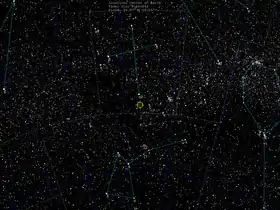 Star map shows star position on the southern edge of the constellation Crux | |
| Observation data Epoch J2000 Equinox J2000 | |
|---|---|
| Constellation | Crux |
| Right ascension | 12h 25m 46.2673s[1] |
| Declination | −64° 01′ 19.516″[1] |
| Apparent magnitude (V) | 6.994[2] |
| Characteristics | |
| Spectral type | F8/G0V[2] |
| B−V color index | 0.537[3] |
| Astrometry | |
| Proper motion (μ) | RA: −182.635±0.030[1] mas/yr Dec.: −60.724±0.027[1] mas/yr |
| Parallax (π) | 25.84 ± 0.31 mas[1] |
| Distance | 126 ± 2 ly (38.7 ± 0.5 pc) |
| Details[3] | |
| Mass | 1.27±0.02 M☉ |
| Luminosity | 1.93 L☉ |
| Surface gravity (log g) | 4.59±0.15 cgs |
| Temperature | 6265±40 K |
| Metallicity [Fe/H] | 0.2±0.06 dex |
| Rotation | 8.7 days |
| Rotational velocity (v sin i) | 5.13 km/s |
| Age | 2.17 Gyr |
| Other designations | |
| Database references | |
| SIMBAD | data |
| Exoplanet Archive | data |
HD 108147, also known as Tupã, is a 7th magnitude star in the constellation of Crux in direct line with and very near to the bright star Acrux or Alpha Crucis. It is either a yellow-white or yellow dwarf (the line is arbitrary and the colour difference is only from classification, not real), slightly brighter and more massive than the Sun. The spectral type is F8 V or G0 V. The star is also younger than the Sun. Due to its distance, about 126 light years, it is too dim to be visible with unaided eye; with binoculars it is an easy target. However, due to its southerly location it is not visible in the northern hemisphere except for the tropics.
An extrasolar planet was detected orbiting it in 2000 by the Geneva Extrasolar Planet Search Team.[4] This exoplanet is "a gas giant smaller than Jupiter that screams around its primary [star] in 11 days at only 0.1 AU." This is much closer than the orbit of Mercury in the Solar System.[5]
In December 2019, the International Astronomical Union announced the star will bear the name Tupã, after the God of the Guarani peoples of Paraguay. The name was a result of a contest ran in Paraguay by the Centro Paraguayo de Informaciones Astronómicas, along with the IAU100 NameExoWorlds 2019 global contest.[6]
It should not be confused with HD 107148, which also has an extrasolar planet discovered in 2006 in the Virgo constellation.
| Companion (in order from star) |
Mass | Semimajor axis (AU) |
Orbital period (days) |
Eccentricity | Inclination | Radius |
|---|---|---|---|---|---|---|
| b / Tumearandu | >0.40 MJ | 0.104 | 10.901 ± 0.001 | 0.498 ± 0.025 | — | — |
See also
References
- 1 2 3 4 5 Brown, A. G. A; et al. (2016). "Gaia Data Release 1. Summary of the astrometric, photometric, and survey properties". Astronomy and Astrophysics. 595. A2. arXiv:1609.04172. Bibcode:2016A&A...595A...2G. doi:10.1051/0004-6361/201629512. S2CID 1828208.Gaia Data Release 1 catalog entry
- 1 2 3 "HD 108147". SIMBAD. Centre de données astronomiques de Strasbourg. Retrieved 2018-04-03.
- 1 2 3 Pepe, F.; et al. (2002). "The CORALIE survey for southern extra-solar planets VII. Two short-period Saturnian companions to HD 108147 and HD 168746". Astronomy and Astrophysics. 388 (2): 632–638. arXiv:astro-ph/0202457. Bibcode:2002A&A...388..632P. doi:10.1051/0004-6361:20020433. S2CID 13942987.
- ↑ "Exoplanets Galore!" (Press release). Garching, Germany: European Southern Observatory. April 15, 2000. Retrieved December 30, 2012.
- ↑ Musgrave, Ian, “Starhopping - The Crux of the Matter” in ‘Sky & Space’ magazine, September–October 2006, Galaxy publishing.
- ↑ "NameExoWorlds Paraguay".
{{cite journal}}: Cite journal requires|journal=(help)
External links